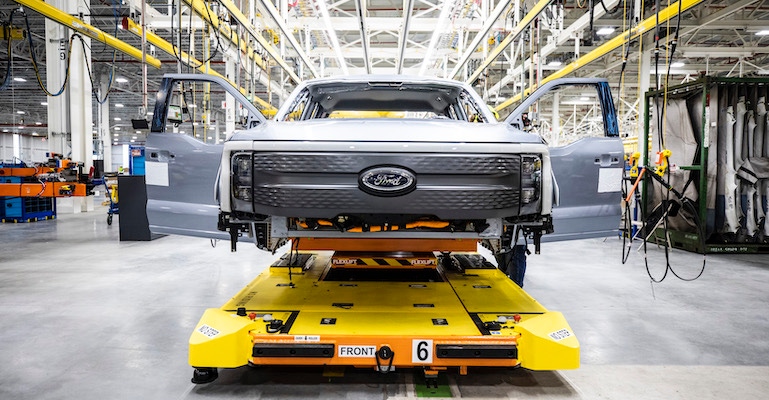Trucks and vans are the workhorses for roofers. As fuel prices skyrocket, experts say it may be time for contractors to rethink what they drive—and how it impacts their brand. But it’s important to understand all the variables first.
March 31, 2022

For years, trade professionals have relied on standard gas- and diesel-powered pickup trucks and vehicles. But a new breed of truck is hitting the market—and experts say it may be time for pros to rethink what they drive.
That’s because electric pickup trucks are now more available than ever including the recently unveiled Ford F-150 Lightning. The first truck, to be released from a major established truck manufacturer, the F-150 retails for $39,974 with a $7,500 in government rebates. That puts it on par with the price of a standard gas-powered F-150.
And that’s the just the start of the electric options that will soon be available in the U.S. Also coming is an electric Chevrolet Silverado truck and the electric Hummer. Down the line, Tesla will enter the market with its much talked about Cybertruck.
Overall, the U.S. electric truck market size was $308.9 million in 2021, and it is expected to grow 54% through 2030. That growth is primarily due to the increasing number of government measures to promote e-mobility and strict emission standards placed on fossil-fuel-powered commercial vehicles, according to Prescient Strategic Intelligence
“Many forward-thinking companies have already started electrifying larger vehicles. New York City plans to convert their public bus system to an all-electric fleet by 2040. Amazon recently ordered 100,000 electric delivery vans with the plan to use the full fleet by 2030,” according to Mike Albert Fleet Solutions.
But before pros jump headfirst into electric vehicles, there’s a number of variables that must be considered. Here are 4 of the most important, according to experts.
Cost. First the good news. Electric vehicles (EVs) including pickup trucks are eligible for a $7,500 federal tax credit as well as thousands in additional state rebates, according to cars.com. For example, that brings the price of the Ford F-150 Lightning down to a surprisingly low price. “Consider that a base F-150 powered by a gas engine starts at $28,940. Factoring in federal and state incentives, we found four states where a base electric F-150 could cost less than a gas one,” according to Motor1.com. Of course, more expensive electric rigs are available, including the Rivian. Pros should check with their tax experts about all the ins and outs of rebates before signing on the dotted line.
Range. Battery technology has improved immensely over the past 5 years. Today’s EVs typically can go 250-350 miles per charge. (The Ford truck offers a standard range of 230 miles per charge.) But unlike a gas-powered truck, charging, even at the fastest rates usually takes up to 30 minutes. So electric rigs might be more suitable for pros with a relatively close-in customer base vs. a large geographic area.
Needs. Electric motors are powerful. Just step on the “gas” and it’s immediate. But cold weather and load require much more energy. “Combustion trucks may be a more efficient choice for lengthy freeway trips—especially if your electric commercial truck is loaded up with cargo. And that doesn’t even take weather into account. EVs don’t generally do well in the cold. Using your heating system in cold weather can sap EV batteries, leaving ranges cut by more than 40 percent,” according to Mike Albert Fleet Solutions.
Image. Going green is a powerful consumer motivator. In fact, 77% of Americans are concerned about the environmental impact of products they buy, according to a recent GreenPrint survey. Letting your customers know that you’re going electric is great way to show them that your firm is taking steps to be an environmentally friendly company—and gain new customers in the process. What’s more the GreenPrint survey shows that 75% of Millennials are willing to pay more for products that are sustainable and environmentally friendly.
Read more about:
sustainabilityYou May Also Like


